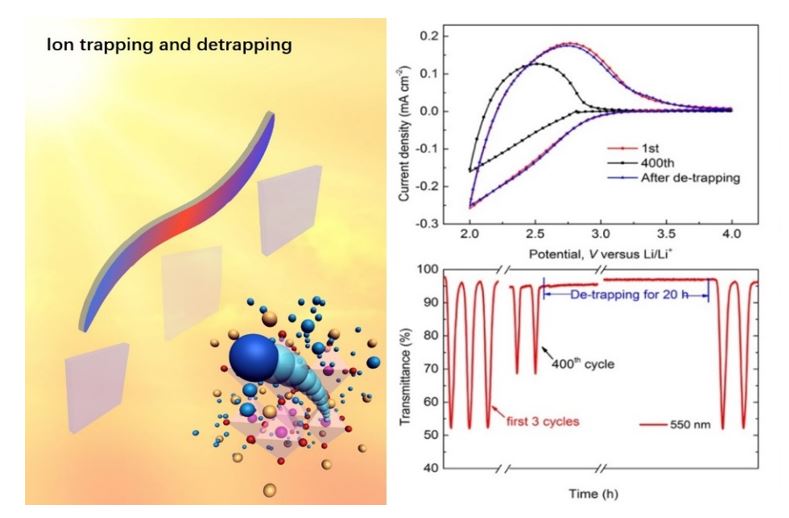Video Article Open Access
Ion Trapping and Detrapping in Amorphous Electrochromic Oxide Thin Films
Rui-Tao Wen
Dept.Materials Science & Engineering, Southern University of Science and Technology (SUSTech), Shenzhen,518055, China
Vid. Proc. Adv. Mater., Volume 2, Article ID 2105184 (2021)
DOI: 10.5185/vpoam.2021.05184
Publication Date (Web): 04 Aug 2021
Copyright © IAAM
Graphical Abstract

Abstract
Electrochromism is classified as materials can reversibly vary their optical absorption under external electrical stimulation. Based on electrochromic phenomenon, devices have been developed for many applications, such as smart windows, information displays, automotive anti-glare rearview mirrors, etc. Compare to other chromic technologies, an advantage of electrochromics is that it has low power consumption and memory-effect, which do not need voltage to hold the “status”. Generally speaking, electrochromic materials can be classified as two catalogues, organic and inorganic. Although organic electrochromic materials demonstrate abundant colors and fast response, they are limited to fast degradation upon cycling. Inorganic electrochromic materials have better environmental and cycle durability. Transition metal oxides represent the most typical inorganic electrochromic materials, and their coloration is based on the reversible insertion and extraction of small ions (H+, Li+, Na+, Zn2+ and Al3+, etc.) in the matrix. During the ion intercalation process, the optical properties of the matrix materials are varied by the charge-balanced electrons from the external circuit. In an ideal case, the number of inserted ions and the extracted ions should be equal. However, the devices showed charge capacity degradation upon cycling which age the optical modulation as well. This leads to the conclusion that the inserted ions are failed to be fully extracted in each cycle, leading to the ion accumulation in the materials matrix.
In this talk, I will present that ion accumulation in the materials matrix stems from an ion trapping process; more importantly, an effective strategy is introduced to refresh the aged devices to regain their initial performance, which is named as ion detrapping. We found three different traps exist in the WO3 matrix, which impedes the optical modulation. Shallow traps only impede the colored state of the optical modulation; deep traps impede both the colored and bleached state; and irreversible traps, which is ignorable, only impede the optical modulation at short wavelengths. Ions trapped in shallow and deep traps can be fully detrapped where the ions trapped in irreversible traps can not be extracted. In another electrochromic oxide, TiO2, shallow traps are found in the matrix and analogous ion trapping procedure is able to rejuvenate to gain the initial performance. These findings show substantial fundamental insight into the ion trapping and detrapping during the ion exchange between ions and materials matrix, and provide a new platform for designing electrochromic devices with superior performance.
Keywords
Electrochromic; Ion trapping and detrapping; rejuvenation.
Acknowledgement
This work is supported by the European Research Council under the European Community’s Seventh Framework Program (FP7/2007–2013)/ERC Grant Agreement No. 267234 (‘GRINDOOR’).
References
- R.T. Wen, G. A. Niklasson, C.-G. Granqvist, Nature Materials, 2015, 14, 994.
- R.T. Wen, M.A. Arvizu, M Morales-Luna, C.-G. Granqvist, G. A. Niklasson, Chemistry of Materials, 2016, 28, 4670.
Biography
Rui-Tao Wen is currently an assistant professor at the Department of Materials Science and Engineering of Southern University of Science and Technology (SUSTech). He obtained B.S. in materials science and engineering from Southeast University in 2008 and Ph.D. in engineering sciences with specialization in solid state physics from Uppsala University in 2016. From 2016 to 2019, he was a postdoctoral associate at the Materials Research Laboratory (MRL), Massachusetts Institute of Technology. His research interests include electrochromic materials and devices, epitaxy growth of semiconductor materials for electric and photonic applications. Dr. Wen has published over 30 research papers on Nature Materials, Nano Lett., Adv. Funct. Mater., Chem. Mater., and Appl. Phys. Lett., etc., and his research has been highlighted by MIT News, Science Daily and Phys.org. He is also a recipient of several awards, including Overseas High-Caliber Personnel (Shenzhen), Torsten Thuréns Prize and StartMIT Award.
Video Proceedings of Advanced Materials

Upcoming Congress



